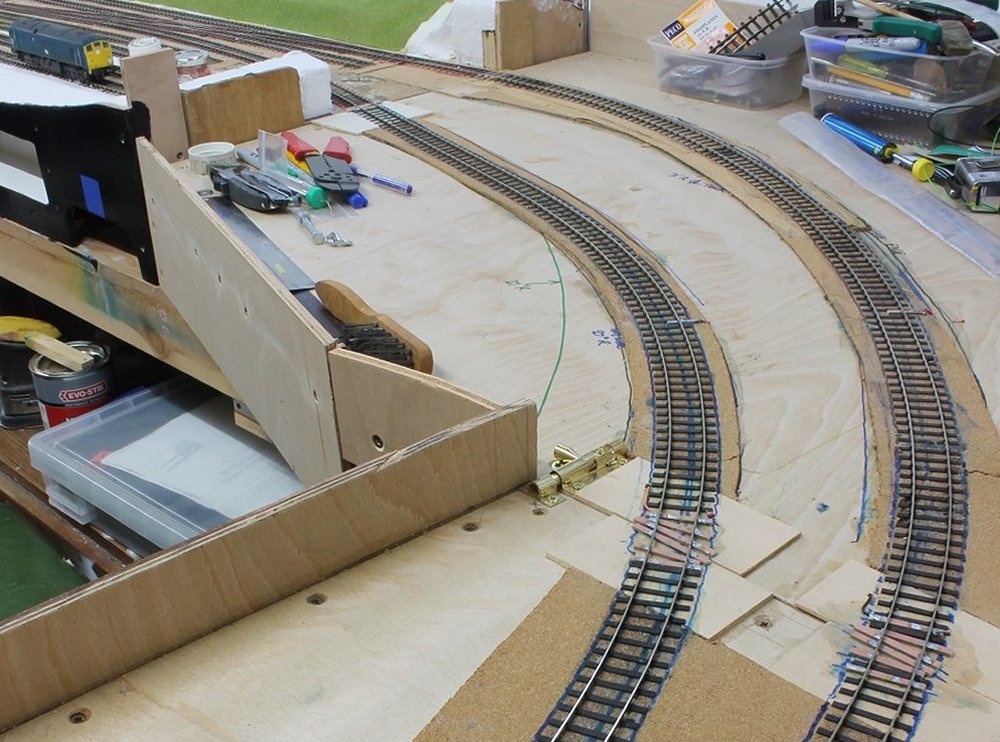*****************************************************************************************************************************************************************
WOOD END SIDINGS
by Paul James
*****************************************************************************************************************************************************************


After many years of not having my own layout to operate, my previous layout Eastwell Ironstone
being too big to set up except at exhibitions, 2020 finally saw me get around to building one.
I dragged down three baseboards out of the loft that had once formed part of a long dismantled
layout that had been in store up there. Each board was 4 ft long by 19" wide (to fit the loft hatch),
and so with a 16ft garage three would fit in, with a spare 4 ft for a fiddle yard. After a trial set up
to see if they would fit in the garage, work on Wood End Sidings started. This first photo shows
the one end of the original layout featuring a double track main line
with a number of exchange sidings. As seen above, originally the tracks started to curve around
at one end as these baseboards formed part of an oval circuit. For the new version of this end to
end layout, the curves would be lifted and straightened out, and the inclined track in the background
(originally going to a cement works) would be removed.

Testing the concept. With the unwanted track lifted, a few of my wagons were placed on the
layout to test the proposed new track layout to see what sort of train lengths I could run
round and expect to accommodate. The original track and pointwork here will stay, as will the
original scenery top right. All the original points were operated by a simple slide switch and
angle cranks with rodding under the baseboard. This will be retained and the new points operated
by the same method. They will be made capable of being power operated in the future if required.

With the basic concept for Wood End Sidings set, replacement trackwork had to be build to
replace the lifted curved sections. This involved building a double slip and three new points.
Two would be used in conjunction with the double slip to provide a connection off the now single
track branch line to a couple of loops, whilst the third would be used in the high level sidings.
They were built from the materials I had to hand at the time, namely rivited wood sleepers and
copper clad sleeper strip with nickle silver bulhead rail. They were designed to be operated in
the same way as the original pointwork.The plain track was C&L nickle silver bullhead lengths

After finishing the trackwork, attention turned to the one big problem with the baseboards as
they stood. They didn't fit properly onto the subframes they sat on, which had originally been
built for a different layout. So widening them would cure that issue. I decided to add 4 inches
to one side of the layout, and 2 inches to the other.

The additional areas would be purely scenic so would have an additional benefit of making the
layout look less crowded with track, which it had tended to do on the original baseboards.
Some of the basic scenic work was started at the same time as the board widening using
polystyrene blocks, plaster bandage and scenic grass mats as a basic ground cover.

The 2 inch extension added to the one side of the layout gave me the opportunity to hide all
the point operating slide switches and the electrical control panel within the footprint of the layout,
something that was important within the tight confines of the garage.

As originally planned, Wood End Sidings would have been a simple end to end layout with a
4 foot fiddle yard at the one end. As the layout developed I realised this concept would not work.
With a bit of careful use of a tape measure I found that a 3 foot radius end curve would just fit
and allow me to move the fiddle yard around to the the other side of the garage, and also allow
for more storage sidings as well.

Rather than have build a lot more pointwork, I decided to use a traverser as part of the fiddle yard.
The one chosen was a Grainge and Hodder 1200mm X 400mm one that comes in kit form, which
I found easy to put together (with help from a second person).

With the layout plan finalised and the baseboards all built, attention could be turned to the scenic
and detailing work required. I liked the idea behind Pete Johnson's Canada Street of not basing
a layout on a location, making the layout anonymous as far a regional identity is concerned.
This would allow me to base it anywhere in the UK with any industry that takes my fancy....
within reason.

The idea to not base Wood End Sidings on any location or region means I have to be careful
when choosing buildings and the like. It is also the reason why there is no signalling on the
layout, access to the sidings at Wood End being controlled by ground frames. All the buffer
stops required on the layout come from the Lanarkshire models extensive range.

Here's the track plan for Wood End Sidings. At the moment apart from the halt at the bottom right
of the plan, the position of the buildings that are going to appear on the layout have not been
decided on. The single track branch runs bottom left to right, with the very basic Wood End Halt
at the RH end. The halt will be only capable of holding a 3 car DMU at a push, and will be very
basic and very much akin to those I remember on the Central Wales Line.
*****************************************************************************************************************************************************************
















